Evaluation of subclinical atherosclerosis in rosacea patients by flow-mediated dilatation method

View/
Date
2022Author
Caf, NazlıÖzkök Akbulut, Tuğba
Can, Mehmet Mustafa
Sarı, Mustafa
Atsü, Ayşe Nilhan
Türkoğlu, Zafer
Metadata
Show full item recordCitation
Caf, N; Ö. Akbulut, T; Can, M. Mustafa; Sarı, Mustafa; Atsü, A. Nilhan; Türkoğlu, Zafer. Evaluation of subclinical atherosclerosis in rosacea patients by flow-mediated dilatation method. Journal of Cosmetic Dermatology (2022); 22(3):1001–1010.Abstract
Background Rosacea may contribute to the development of cardiovascular (CV) diseases by causing endothelial dysfunction (ED), which is known to be the initial step of atherosclerosis, due to its inflammatory features. Objective This study aimed to assess ED in rosacea patients using the flow-mediated dilatation (=dilation) (FMD) method. Methods Seventy-three rosacea patients and 73 age, gender-matched healthy volunteers were enrolled. Individuals with cardiac risk factors, pregnant, and lactating women were excluded. Demographic, clinical data and anthropometric measurements were recorded. FMD measurement was performed ultrasonographically by a cardiologist. Systolic and diastolic blood pressures (BP) were measured and hemogram, erythrocyte sedimentation rate (ESR), C-Reactive Protein (CRP), total cholesterol, triglyceride, low-density lipoprotein (LDL), high-density lipoprotein (HDL), neutrophil/lymphocyte ratio (NLR), platelet/lymphocyte ratio (PLR), mean platelet volume (MPV), and fasting blood glucose values were assessed. Results The FMD value was statistically lower in rosacea patients compared with healthy controls (p = 0.000). Metabolic syndrome, systolic and diastolic BPs, and plasma NLR were higher in the rosacea group (p = 0.009, p = 0.000, p = 0.000, p = 0.000, respectively). According to the multivariate linear regression analysis, rosacea type significantly predicted FMD. Conclusions Rosacea is not only a disease limited to the skin, but it may also have systemic involvement. A significant difference was found between FMD values measured in between the case and control groups, suggesting rosacea may have an atherogenic effect. Possible cardiac risks should be considered in rosacea patients, and further evaluation could be warranted.

















